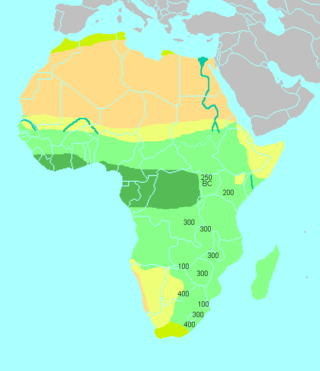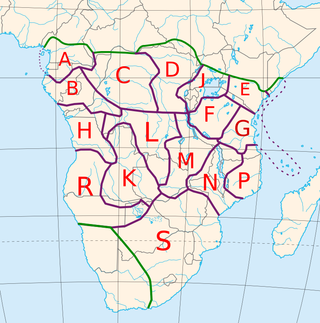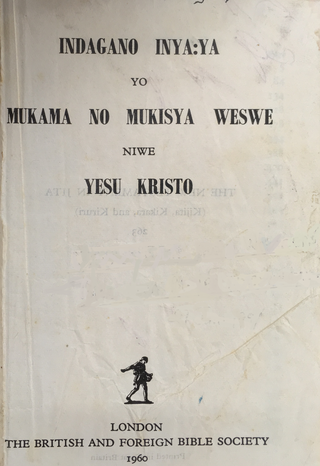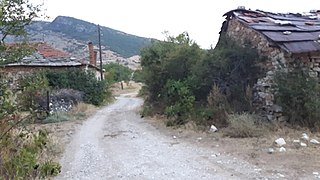Related Research Articles

The Bantu languages are a large family of languages spoken by the Bantu people of Central, Southern, and Southeast Africa. They form the largest branch of the Southern Bantoid languages.

Niger–Congo is a hypothetical language family spoken over the majority of sub-Saharan Africa. It unites the Mande languages, the Atlantic-Congo languages, and possibly several smaller groups of languages that are difficult to classify. If valid, Niger-Congo would be the world's largest in terms of member languages, the third-largest in terms of speakers, and Africa's largest in terms of geographical area. It is generally considered to be the world's largest language family in terms of the number of distinct languages, just ahead of Austronesian, although this is complicated by the ambiguity about what constitutes a distinct language; the number of named Niger–Congo languages listed by Ethnologue is 1,540.

The Bantu expansion is a hypothesis about the history of the major series of migrations of the original Proto-Bantu-speaking group, which spread from an original nucleus around Central Africa across much of sub-Saharan Africa. In the process, the Proto-Bantu-speaking settlers displaced or absorbed pre-existing hunter-gatherer and pastoralist groups that they encountered.

The 250 or so "Narrow Bantu languages" are conventionally divided up into geographic zones first proposed by Malcolm Guthrie (1967–1971). These were assigned letters A–S and divided into decades ; individual languages were assigned unit numbers, and dialects further subdivided. This coding system has become the standard for identifying Bantu languages; it was the only practical way to distinguish many ambiguously named languages before the introduction of ISO 639-3 coding, and it continues to be widely used. Only Guthrie's Zone S is (sometimes) considered to be a genealogical group. Since Guthrie's time a Zone J has been set up as another possible genealogical group bordering the Great Lakes.
Fwe, or Chifwe, is a Bantu language spoken by 10,000 people along the Okavango River in the Zambezi region of Namibia and in the Western Province in Zambia. It is closely related to Kuhane, and is one of several Bantu languages of the Okavango which have click consonants.
Chuwabo (Echuwabo), also spelled Cuabo and Txuwabo, is a Bantu language spoken along the central coast of Mozambique.
The Zigula or Zigua language, Chizigua, is a Bantu language of Tanzania and Somalia, where the Mushunguli dialect is spoken.
Tikar is a Northern Bantoid, semi-Bantu language that is spoken in Cameroon by the Tikar people, as well as by the Bedzan Pygmies, who speak their own dialect of the language. According to linguist and anthropologist Harry H. Johnston, wemi-Bantu and Bantu syntax suggests influence from mixed dynastic Egyptians and the "Negro languages in western and central Sudan." However, a more recent hypothesis by Roger Blench suggests that the Tikar language could be a divergent language in the Niger-Congo language family with an uncertain origin.
The Kango (Bakango), also known as the Batchua and Mbuti-Sua, are an Mbuti pygmy people of the Ituri forest. They speak a Bantu language, Bila, apparently in two dialects, northern Sua and southern Kango.
The Asua or Asoa, also known as the Aka, are an Mbuti pygmy people of the Ituri forest. They speak a Central Sudanic language, Asuati, and are the only Pygmy group in the east to have their own language, though it is closely related to Mangbetu.
Lengola (Lengora) is a Bantu language of the Democratic Republic of the Congo. It is not close to other Bantu languages. It may be closest to some of the D.30 languages in a group called "Lebonya".
Bali is a Bantu language spoken in the Bafwasende Territory of the Democratic Republic of the Congo. It has been included in Boan and seems to be most closely related to Lika.
Yans (Yanzi) is a Bantu language spoken in the Democratic Republic of the Congo by the Bayanzi.
Lika can refer to:

Jita is a Bantu language of Tanzania, spoken on the southeastern shore of Lake Victoria/Nyanza and on the island of Ukerewe.
Holoholo is a Bantu language of DR Congo and formerly in Tanzania spoken by the Holoholo people on either side of Lake Tanganyika. Classification is uncertain, but it may belong with the Takama group.
Boan is a proposed intermediate group of Bantu languages coded Zones C and D in Guthrie's classification. There are three branches:
Dong, or Donga, is a poorly documented language in Nigeria. Though clearly Niger–Congo, it is difficult to classify; British linguist Roger Blench proposes that it is one of the Dakoid languages, the closest to Gaa.

The Bantu peoples, or Bantu, are an ethnolinguistic grouping of approximately 400 distinct ethnic groups who speak Bantu languages. They are native to 24 countries spread over a vast area from Central Africa to Southeast Africa and into Southern Africa. There are several hundred Bantu languages. Depending on the definition of "language" or "dialect", it is estimated that there are between 440 and 680 distinct languages. The total number of speakers is in the hundreds of millions, ranging at roughly 350 million in the mid-2010s. About 60 million speakers (2015), divided into some 200 ethnic or tribal groups, are found in the Democratic Republic of the Congo alone.

Prisad is a village in Municipality of Prilep. The village, along with 3 other villages, are known for being the name of an Antarctic Island.
References
- ↑ Lika at Ethnologue (18th ed., 2015) (subscription required)
- ↑ Jouni Filip Maho, 2009. New Updated Guthrie List Online
- Wit, Gerrit de (2015). Liko phonology and grammar : a Bantu language of the Democratic Republic of the Congo (Ph.D. thesis). Leiden University. hdl: 1887/36066 .